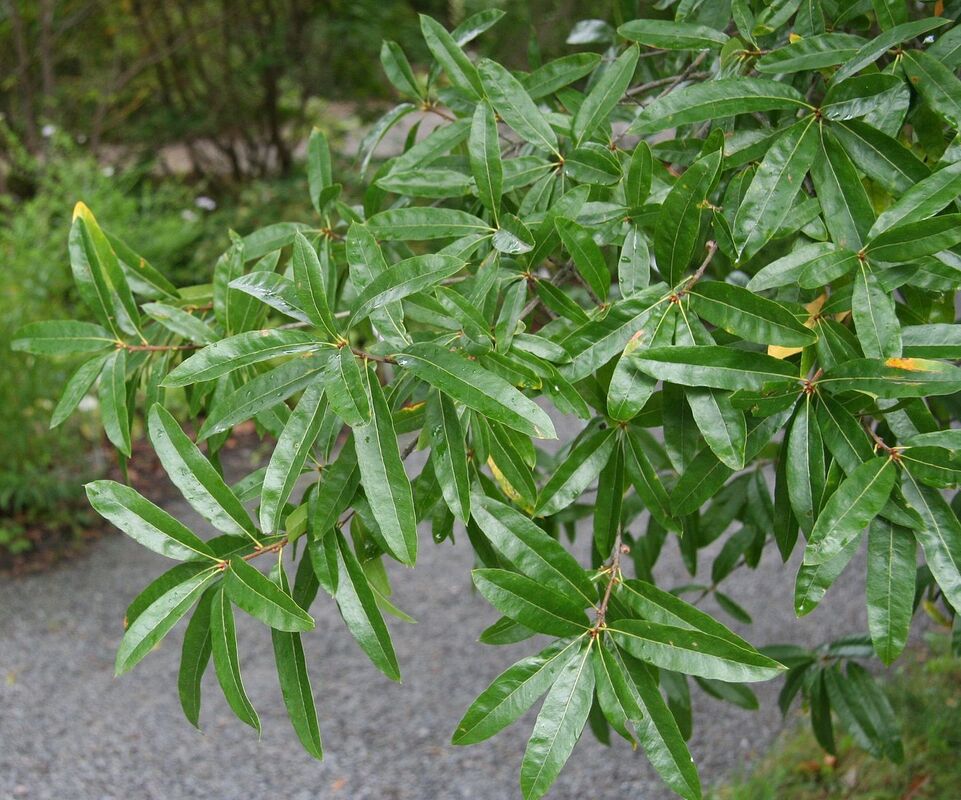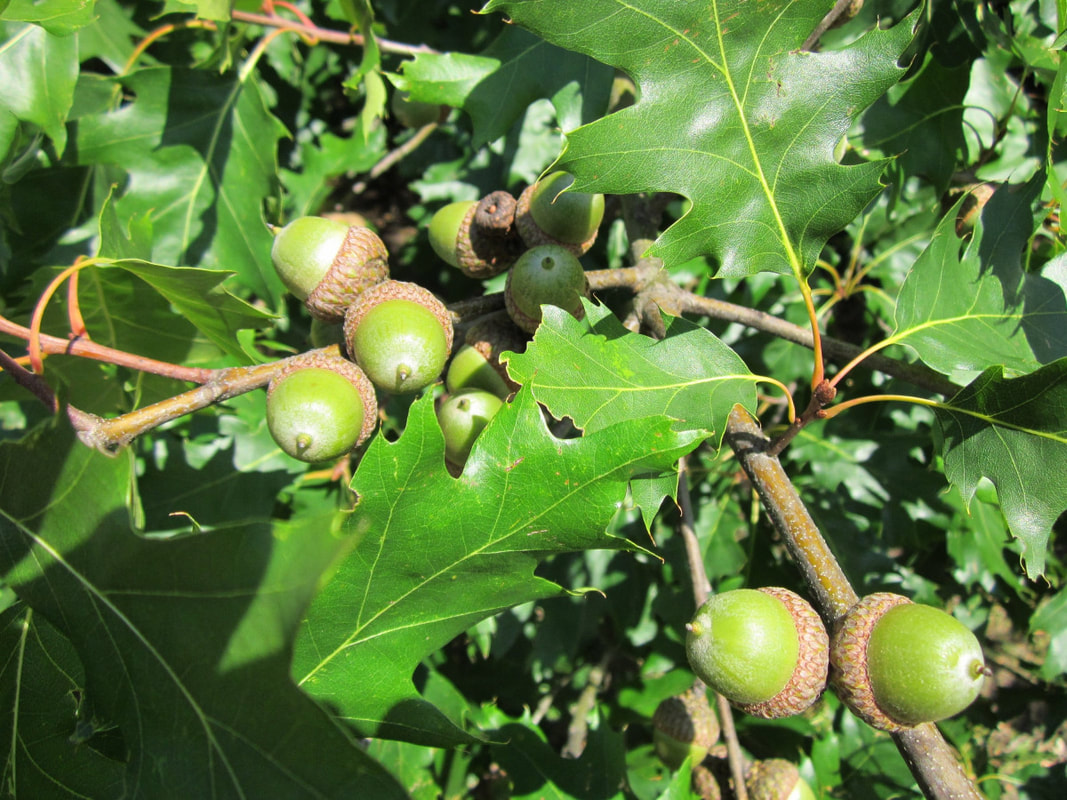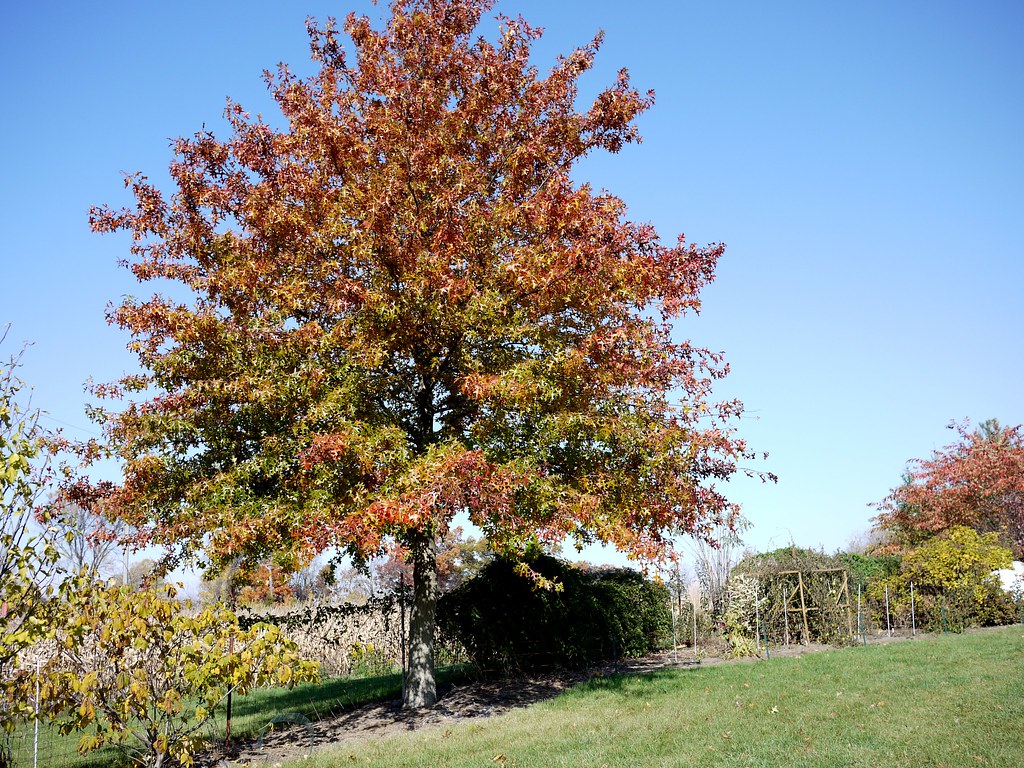HRA Native Canopy Tree Fund
The HRA Native Canopy Tree Fund is here!
This fund will offer civic association members a dollar-for-dollar reimbursement of up to $200 toward the purchase and installation of native canopy trees on their properties, awarded on a first-come, first-served basis each year. To qualify, simply:
Qualifying tree species include (source: PlantNovaNatives.org):
If you're unsure if a certain species will qualify, email us at [email protected].
To illustrate the tree fund in action, see below:
Example 1: You purchase three small oak saplings from a local nursery for $20 each. You plant them yourself, between September and November. You email [email protected] pictures of each planted sapling, and your receipt. With a dollar-for-dollar match, the HRACA writes you a reimbursement check for $30.
Example 2: You purchase an 8' tall red maple at a local nursery for $200. The nursery charges an additional $200 for delivery and installation, for a total cost of $400. You schedule your installation sometime between September and November. Once planted, you email [email protected] a picture of the newly planted tree and your receipt. With a dollar-for-dollar match up to $200, the HRACA writes you a reimbursement check for $200.
Example 3: You purchase a 10' hickory at a local nursery for $300. The nursery charges an additional $300 for delivery and installation, for a total cost of $600. You schedule your installation sometime between September and November. Once planted, you email [email protected] a picture of the newly planted tree and your receipt. With a dollar-for-dollar match up to $200, HRACA writes you a reimbursement check for $200.
This effort will be largely funded by resident donations, so please be on the lookout for this option on your next annual membership form. The more donations we get, the more households we can support in enhancing and maintaining the beautiful native canopy our neighborhood enjoys!
Thank you to all who participated in the 70 Trees for 70 Years effort last Fall! 137 saplings and 35 mature trees were planted. Each native tree planted is an investment in our neighborhood, our ecosystem and the next generation!
This fund will offer civic association members a dollar-for-dollar reimbursement of up to $200 toward the purchase and installation of native canopy trees on their properties, awarded on a first-come, first-served basis each year. To qualify, simply:
- Purchase and install a native canopy tree between September and November
- E-mail your receipt and a picture of your newly planted tree to [email protected]
- In your email, opt into periodic tree watering email reminders from us, and agree to watering your tree as needed for the first year after planting, to help it get established.
Qualifying tree species include (source: PlantNovaNatives.org):
If you're unsure if a certain species will qualify, email us at [email protected].
To illustrate the tree fund in action, see below:
Example 1: You purchase three small oak saplings from a local nursery for $20 each. You plant them yourself, between September and November. You email [email protected] pictures of each planted sapling, and your receipt. With a dollar-for-dollar match, the HRACA writes you a reimbursement check for $30.
Example 2: You purchase an 8' tall red maple at a local nursery for $200. The nursery charges an additional $200 for delivery and installation, for a total cost of $400. You schedule your installation sometime between September and November. Once planted, you email [email protected] a picture of the newly planted tree and your receipt. With a dollar-for-dollar match up to $200, the HRACA writes you a reimbursement check for $200.
Example 3: You purchase a 10' hickory at a local nursery for $300. The nursery charges an additional $300 for delivery and installation, for a total cost of $600. You schedule your installation sometime between September and November. Once planted, you email [email protected] a picture of the newly planted tree and your receipt. With a dollar-for-dollar match up to $200, HRACA writes you a reimbursement check for $200.
This effort will be largely funded by resident donations, so please be on the lookout for this option on your next annual membership form. The more donations we get, the more households we can support in enhancing and maintaining the beautiful native canopy our neighborhood enjoys!
Thank you to all who participated in the 70 Trees for 70 Years effort last Fall! 137 saplings and 35 mature trees were planted. Each native tree planted is an investment in our neighborhood, our ecosystem and the next generation!
NATIVE TREE SELECTION GUIDE
Why Native Trees?
Native plants are already well-adapted to our region’s climate, so they:
Canopy trees, in particular, provide:
Why saplings?
Read more here: Tree Size Matters
PLEASE READ:
How I Killed a Tree (And the Lessons I Learned)
ALSO READ THIS:
How to easily test your soil yourself:
https://www.nrcs.usda.gov/wps/portal/nrcs/detail/soils/edu/?cid=nrcs142p2_054311
How to water your newly planted tree:
They should be watered at planting time and at these intervals:
More valuable information about how much to water, and how to water (not as straightforward as you might think!) here: Watering newly planted trees and shrubs | UMN Extension
Why Native Trees?
Native plants are already well-adapted to our region’s climate, so they:
- are more resilient and require less maintenance (e.g. don’t need fertilizing or long-term watering)
- have critical ecological value, including providing food & habitat for many species that make up the food web our ecosystems rely on!
Canopy trees, in particular, provide:
- reduced surface and air temperatures (as much as 10-45 F!) and improved air quality
- enhanced stormwater management and water quality
- improved quality of life including aesthetic value and reduced noise
Why saplings?
- Saplings require less time, attention and water to establish than larger trees
- They are easy to plant and inexpensive
- Younger trees have resilient root systems that can better overcome the stress of being planted— in 5-10 years, a tree that is planted when it is younger will likely be taller and healthier than a larger tree planted at the same time
Read more here: Tree Size Matters
PLEASE READ:
How I Killed a Tree (And the Lessons I Learned)
ALSO READ THIS:
- If you have a mature tree you value, consider planting a sapling or two of the same species as a “legacy tree”, so when that tree dies you already have its replacement growing. We only recommend planting one-gallon saplings for this purpose so as not to disturb the existing tree’s critical root zone.
- Don't plant trees that grow large beneath power lines, close to your house (at least 15 feet from foundations), or in other potentially hazardous sites.
- Plant small trees at least 10-15’ away from buried utility/sewer lines, and larger ones at least 20’. Note that if you have anything other than PVC pipes, they are much more susceptible to tree root damage, so use the mature spread of the tree canopy as your guide (e.g. 40’ canopy, plant 30-40’ away). Look for trees described as slower growing and having a deep tap root - that means the roots won’t stay close to the surface where they are more likely to interfere with utilities. Oaks, ironwood and redbuds are good examples of these.
- Give trees adequate rooting space, with no obstructions. Sturdy trees have straight main roots. Curbs, foundations, and sidewalks all act as barriers to roots, making them turn and twist. A tree with twisted roots will not be as stable as one with strong, straight roots.
- Plenty of trees are planted closer to driveways/curbs or sewer lines/other utilities with little to no issue, so these are not hard rules, but we want you to be aware of any potential risks over time as you decide where to site your trees. The recommended trees are all hardy, but these factors may slightly reduce their mature size or lifespan, or require a low level of additional maintenance, e.g. limited annual use of root killer down pipes to ensure no damage.
- If you can, plant trees in groups. Trees planted in groups are much better protected in high winds. In addition, trees planted in combination with appropriate shrubs and groundcovers form effective windbreaks and wildlife habitat.
- Position trees and shrubs strategically to naturally cool or heat your home. Plant deciduous shade trees on the south, east, and west sides of a house to cast shade in summer and allow warming in winter. Tree shade can reduce air conditioning costs significantly—an air-conditioning system's outdoor compressor/condenser unit uses less energy when it is shaded from direct sun during the day. Just be careful not to block the unit's airflow with low branches.
How to easily test your soil yourself:
https://www.nrcs.usda.gov/wps/portal/nrcs/detail/soils/edu/?cid=nrcs142p2_054311
How to water your newly planted tree:
They should be watered at planting time and at these intervals:
- Water daily from weeks 0-2 after planting
- Water every two to three days from weeks 3-12 after planting
- After 12 weeks, water weekly until roots are established (at least one year)
More valuable information about how much to water, and how to water (not as straightforward as you might think!) here: Watering newly planted trees and shrubs | UMN Extension
Tuliptree (Liriodendron tulipfera)
One of the tallest and most beautiful eastern hardwoods, 60-90’ tall, with a long, straight trunk, a narrow crown that spreads with age, and large showy flowers resembling tulips. It is an excellent shade or ornamental tree, sited best on lower or concave slopes. Fast growing. Best grown in moist but well-drained loams in full sun. Tolerates part shade. This is a favorite nesting tree for birds and the flowers attract hummingbirds. It’s also the only host plant for the caterpillars of the tuliptree silkmoth and one of the host plants for tiger swallowtail caterpillars!
Sources/more info:
Images: 1. Photo by Vicki DeLoach / CC BY 3.0 | 2. Photo by Amada44 / CC BY 3.0
One of the tallest and most beautiful eastern hardwoods, 60-90’ tall, with a long, straight trunk, a narrow crown that spreads with age, and large showy flowers resembling tulips. It is an excellent shade or ornamental tree, sited best on lower or concave slopes. Fast growing. Best grown in moist but well-drained loams in full sun. Tolerates part shade. This is a favorite nesting tree for birds and the flowers attract hummingbirds. It’s also the only host plant for the caterpillars of the tuliptree silkmoth and one of the host plants for tiger swallowtail caterpillars!
Sources/more info:
- Liriodendron tulipifera - Plant Finder
- Liriodendron tulipifera (Tulip tree) | Native Plants of North America
Images: 1. Photo by Vicki DeLoach / CC BY 3.0 | 2. Photo by Amada44 / CC BY 3.0
Hackberry (Celtis occidentalis) - a medium to large deciduous tree that typically grows 40-60’ tall with upright-arching branching and a rounded spreading crown. Female flowers give way to an often abundant fruit crop that are attractive to a variety of wildlife. Fleshy parts of the fruit are edible. Tough shade tree that grows in a wide range of soils in full to part sun.
More info/source: Celtis occidentalis - Plant Finder
Images: 1. Photo by Karelj / CC BY 3.0 | 2. Photo by Sten Porse / CC BY 3.0 | 3. Photo by Kerry Woods / CC BY 3.0
More info/source: Celtis occidentalis - Plant Finder
Images: 1. Photo by Karelj / CC BY 3.0 | 2. Photo by Sten Porse / CC BY 3.0 | 3. Photo by Kerry Woods / CC BY 3.0
Sycamore (Plantanus occidentalis)- a wide-canopied, deciduous tree, 75-100’ tall, with a massive trunk and open crown of huge, crooked branches. The patchwork bark – brown, orange, green and of course, white – make these trees jump out, especially in the winter landscape. This plant prefers full sun & moist, fertile soils. It is tolerant of clay, sand, loam, alkaline, and wet soils with moderate drought tolerance. When siting this tree on your landscape, keep in mind that this will be a large tree for a large space.
More info/sources:
https://www.wildflower.org/plants/result.php?id_plant=ploc
https://www.scottarboretum.org/plant-of-the-month-platanus-occidentalis/
Images: 1. Photo by Bruce Marlin / CC BY 3.0 | 2. Photo / CCO Public Domain
More info/sources:
https://www.wildflower.org/plants/result.php?id_plant=ploc
https://www.scottarboretum.org/plant-of-the-month-platanus-occidentalis/
Images: 1. Photo by Bruce Marlin / CC BY 3.0 | 2. Photo / CCO Public Domain
Black cherry (Prunus serotina)- one of the largest of the cherries, typically growing to 50-80’ tall with a narrow-columnar to rounded crown. Noted for its profuse spring bloom, attractive summer foliage and fall color. Easily grown in average, medium, well-drained soils in full sun to part shade. Best in moist, fertile loams. Cherries are a bit sour to eat but can be used in baking and are tremendously important for pollinators, hosting an incredible 456 butterflies and moths, along with other wildlife virtues.
More info/source: Prunus serotina - Plant Finder
Images: 1. Photo by Gmihail / CC BY 3.0 | 2. Photo by Rasbak / CC BY 3.0
More info/source: Prunus serotina - Plant Finder
Images: 1. Photo by Gmihail / CC BY 3.0 | 2. Photo by Rasbak / CC BY 3.0
Willow Oak (Quercus phellos) - a handsome oak with willow-like leaves. Foliage is light to bright green in summer and yellow, yellow-brown and russet in fall. Relatively fast-growing. Grows to 40-60' with a 35' spread. Prefers full sun and adapts to a wide range of soil conditions including clays with somewhat poor drainage. High wildlife value.
More info/sources:
Images: 1. Photo by Freekhou5 / CC BY-SA 4.0 | 2. Photo by Michael Wolf / CC BY 3.0
More info/sources:
Images: 1. Photo by Freekhou5 / CC BY-SA 4.0 | 2. Photo by Michael Wolf / CC BY 3.0
Red Oak (Quercus rubra) - a medium sized, deciduous tree with a rounded to broad-spreading, often irregular crown. Typically grows at a moderate-to-fast rate to a height of 50-75' tall. A durable and long-lived tree that grows best in full sun with dry to medium moisture. Attracts butterflies and hummingbirds!
More info/source:
Quercus rubra - Plant Finder
Images: 1. Photo / Public Domain | 2. Photo / Public Domain
More info/source:
Quercus rubra - Plant Finder
Images: 1. Photo / Public Domain | 2. Photo / Public Domain
Pin Oak (Quercus palustris)- a graceful lawn tree with regular compact form and fine-textured foliage that typically grows 50-70’ tall with a broad pyramidal crown in medium to wet soil in full sun. Dark-green foliage becomes dark-red in fall. Leaves persist into winter. Attracts birds butterflies, and hummingbirds, and is the larval host for the Gray Hairstreak.
More info/source: Plant Finder - Quercus palustris
Images: 1. Photo by Rafael Medina/ CC BY 2.0 | 2. Photo by F. D. Richards / CC BY 2.0
More info/source: Plant Finder - Quercus palustris
Images: 1. Photo by Rafael Medina/ CC BY 2.0 | 2. Photo by F. D. Richards / CC BY 2.0
Persimmon (Diospyros virginiana) - an attractive tree with reddish purple fall foliage, distinctive rectangular-blocked dark gray bark, and a rounded oval crown that grows to 35-60’ tall. Somewhat wide range of soil tolerance, but prefers moist, sandy soils. Drought tolerant. Promptly remove root suckers unless naturalized effect is desired. Female trees need a male pollinator in order to set fruit.
More info/sources:
https://www.plantnovanatives.org/native-tree-choices (image 1)
Diospyros virginiana - Plant Finder (image 2)
Images: 1. Photo by frederick.forestryboard.org - Bethany Dell'Agnello / CC BY 2.0 | 2. Photo by Elizabeth Sellers / CC BY NC SA 2.0
More info/sources:
https://www.plantnovanatives.org/native-tree-choices (image 1)
Diospyros virginiana - Plant Finder (image 2)
Images: 1. Photo by frederick.forestryboard.org - Bethany Dell'Agnello / CC BY 2.0 | 2. Photo by Elizabeth Sellers / CC BY NC SA 2.0
Ironwood (Carpinus caroliniana) - an attractive slow-growing, deciduous, small to medium-sized understory tree, 20’-35’ tall, with an attractive globular form for shadier sites. Can tolerate dry to wet. Its muscle-like bark makes it a nice native alternative to crepe myrtle and has earned it its other common name, “musclewood.”
More info/sources:
Carpinus caroliniana - Plant Finder
https://www.plantnovanatives.org/native-tree-choices
Images: 1. Photo by Sherief Saleh / CC BY SA 3.0 | 2. Photo by Tom Potterfield / CC BY NC SA 2.0
More info/sources:
Carpinus caroliniana - Plant Finder
https://www.plantnovanatives.org/native-tree-choices
Images: 1. Photo by Sherief Saleh / CC BY SA 3.0 | 2. Photo by Tom Potterfield / CC BY NC SA 2.0
Redbud (Cercis canadensis) - common understory tree, reaching 15-30’ tall with a similar spread. Prefers part-sun, happy in a range of conditions, including wet and will tolerate drought when established. Has sweet heart-shaped leaves! Fuchsia flower clusters along bare branches appear before leaves in early spring. Attracts butterflies to flowers; birds & mammals to seeds; larval host for Henry’s Elfin & Io moth.
More info:
https://mgnv.org/wp-content/uploads/2018/12/Cercis-canadensisF2-L.pdf
Images: 1. Photo by Lambique / CC BY SA 3.0 | 2. Photo by Judy Gallagher / CC BY 2.0
–
ADDITIONAL RESOURCES
Tree Placement: Right Plant, Right Place
Planting and Establishing Trees - Gardening Solutions - University of Florida, Institute of Food and Agricultural Sciences
Tree Placement on Home Grounds | MU Extension
https://www.plantnovanatives.org/
https://choosenatives.org/wp-content/uploads/2020/04/City_of_Falls_Church_Mulch_flyer.pdf
More info:
https://mgnv.org/wp-content/uploads/2018/12/Cercis-canadensisF2-L.pdf
Images: 1. Photo by Lambique / CC BY SA 3.0 | 2. Photo by Judy Gallagher / CC BY 2.0
–
ADDITIONAL RESOURCES
Tree Placement: Right Plant, Right Place
Planting and Establishing Trees - Gardening Solutions - University of Florida, Institute of Food and Agricultural Sciences
Tree Placement on Home Grounds | MU Extension
https://www.plantnovanatives.org/
https://choosenatives.org/wp-content/uploads/2020/04/City_of_Falls_Church_Mulch_flyer.pdf






















